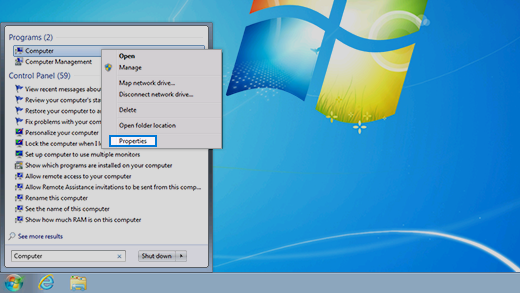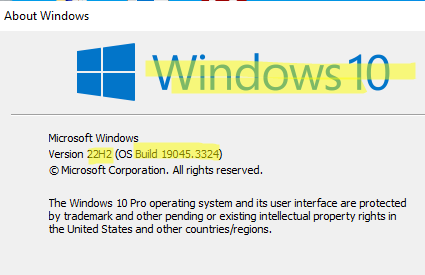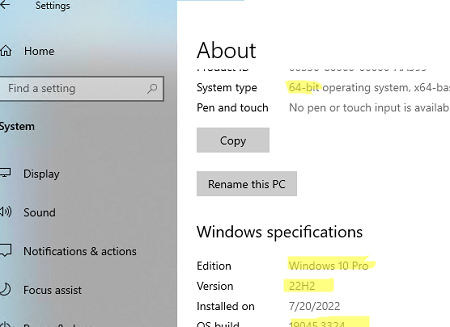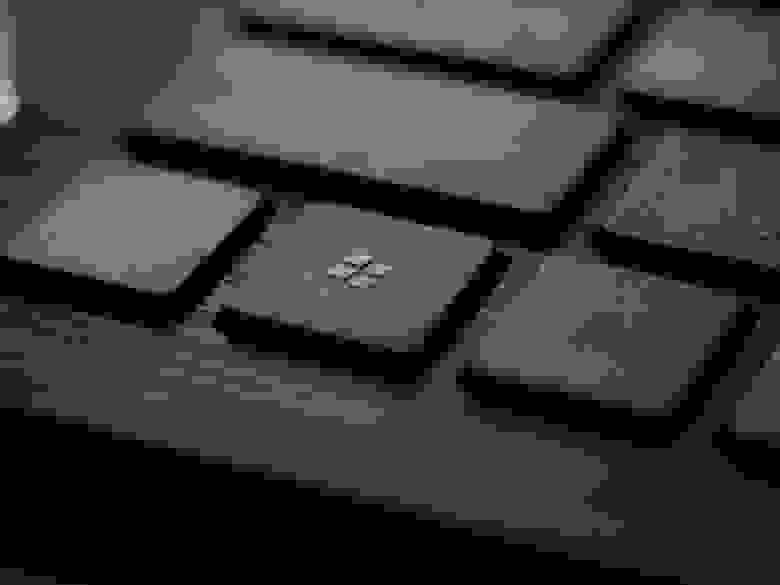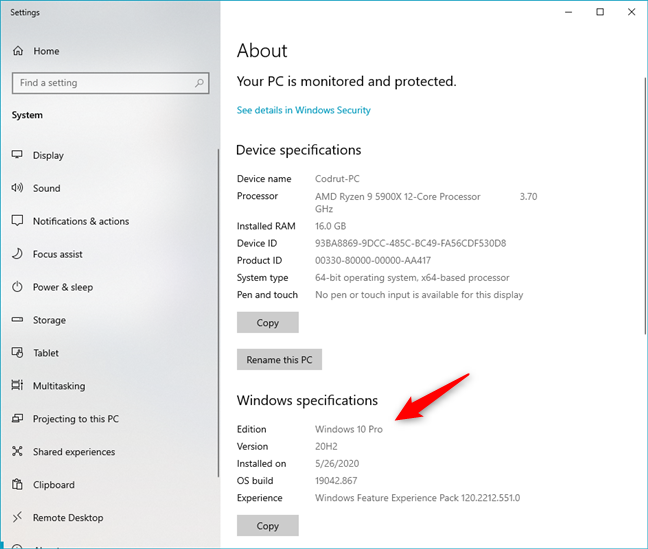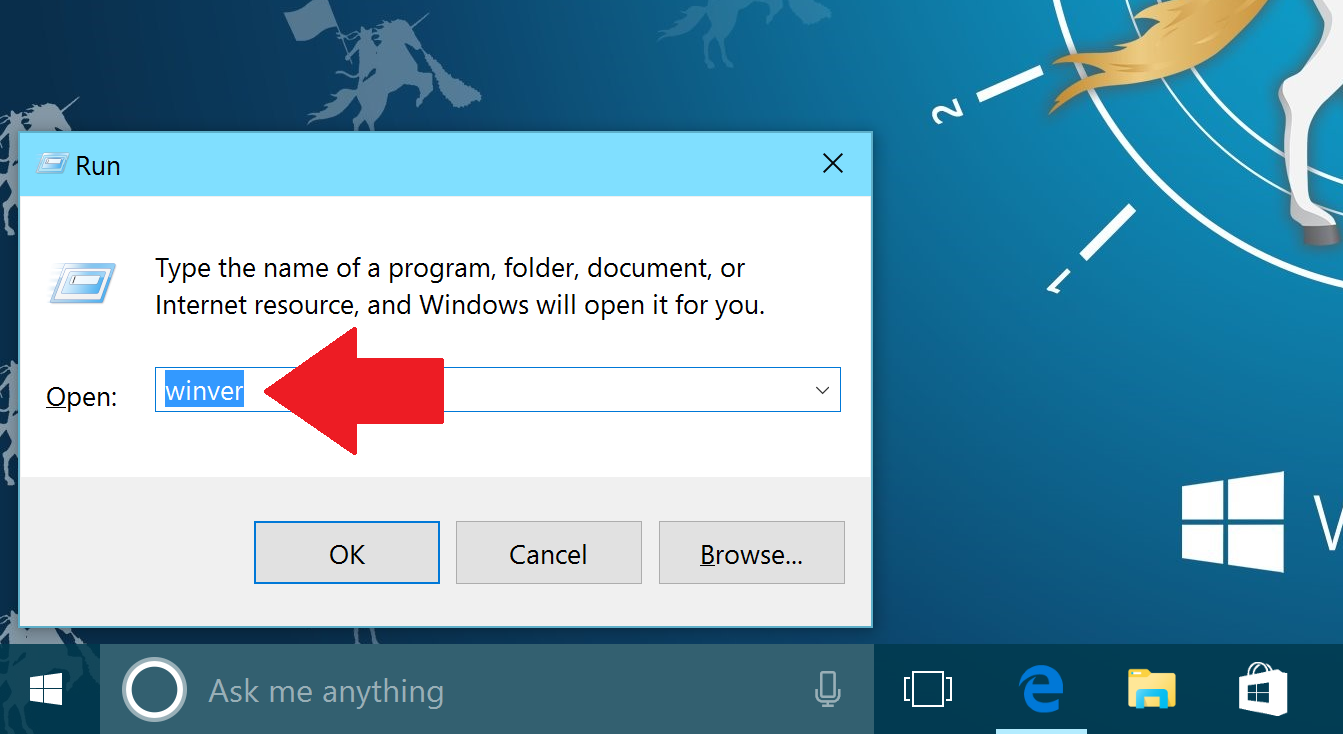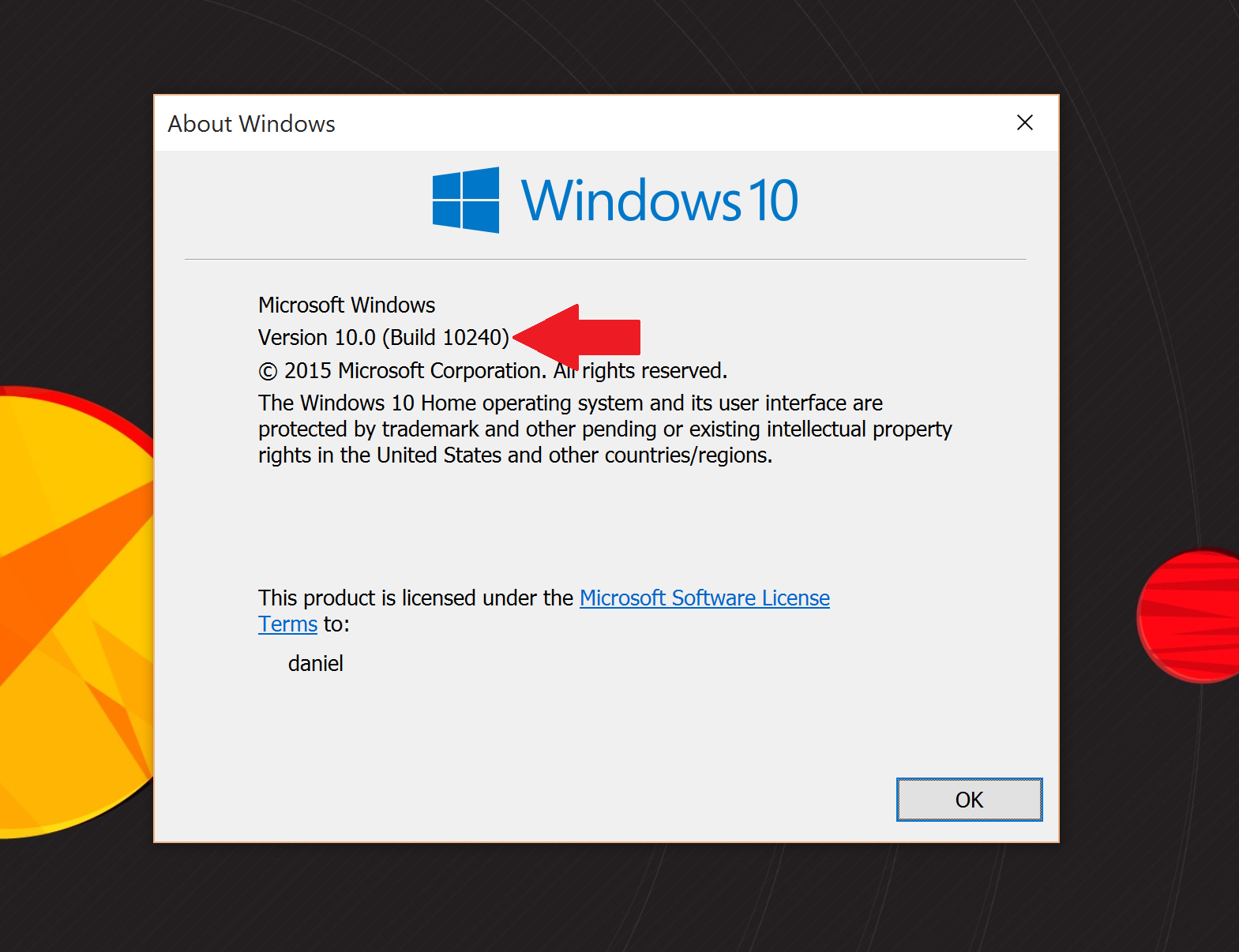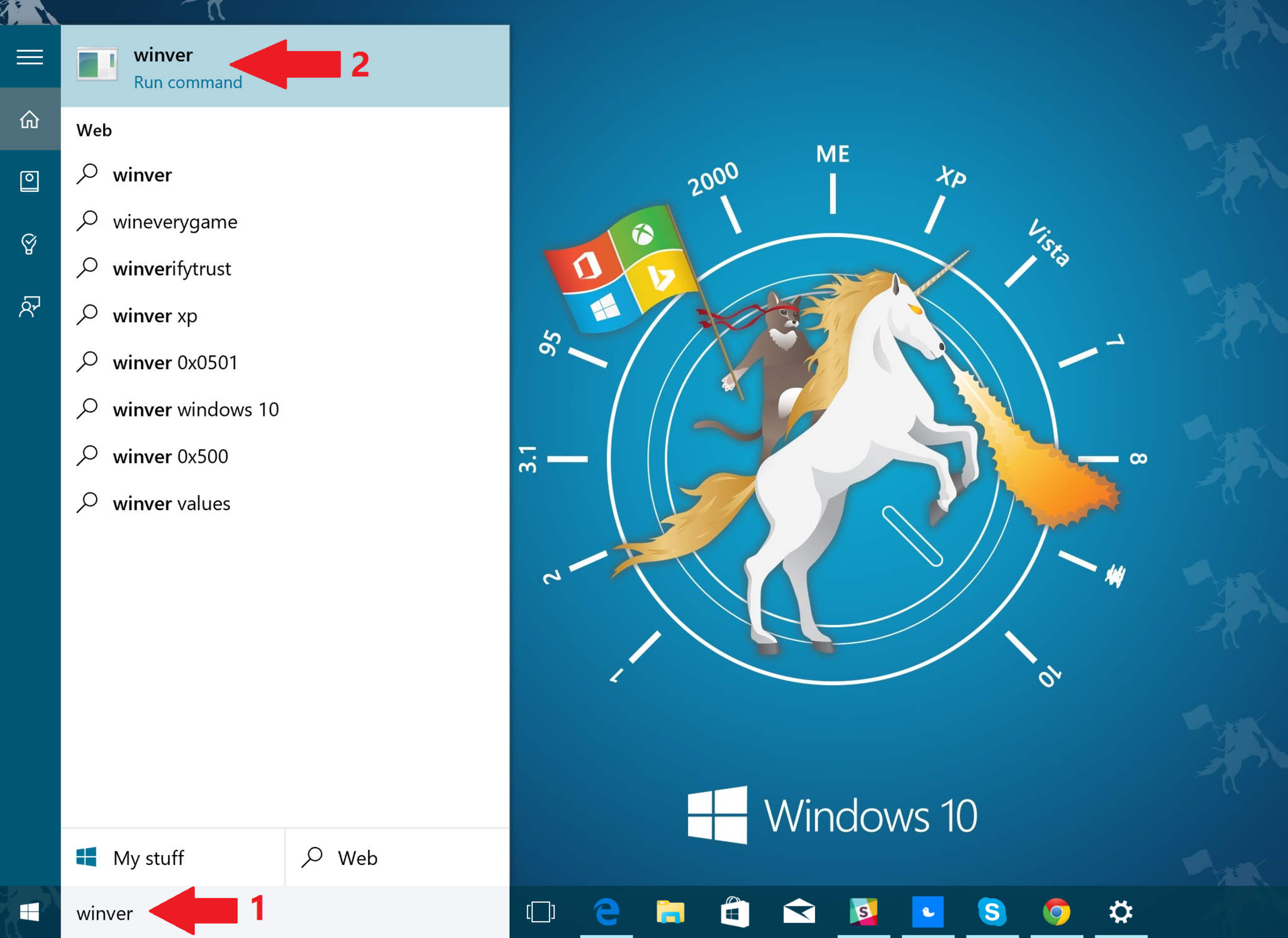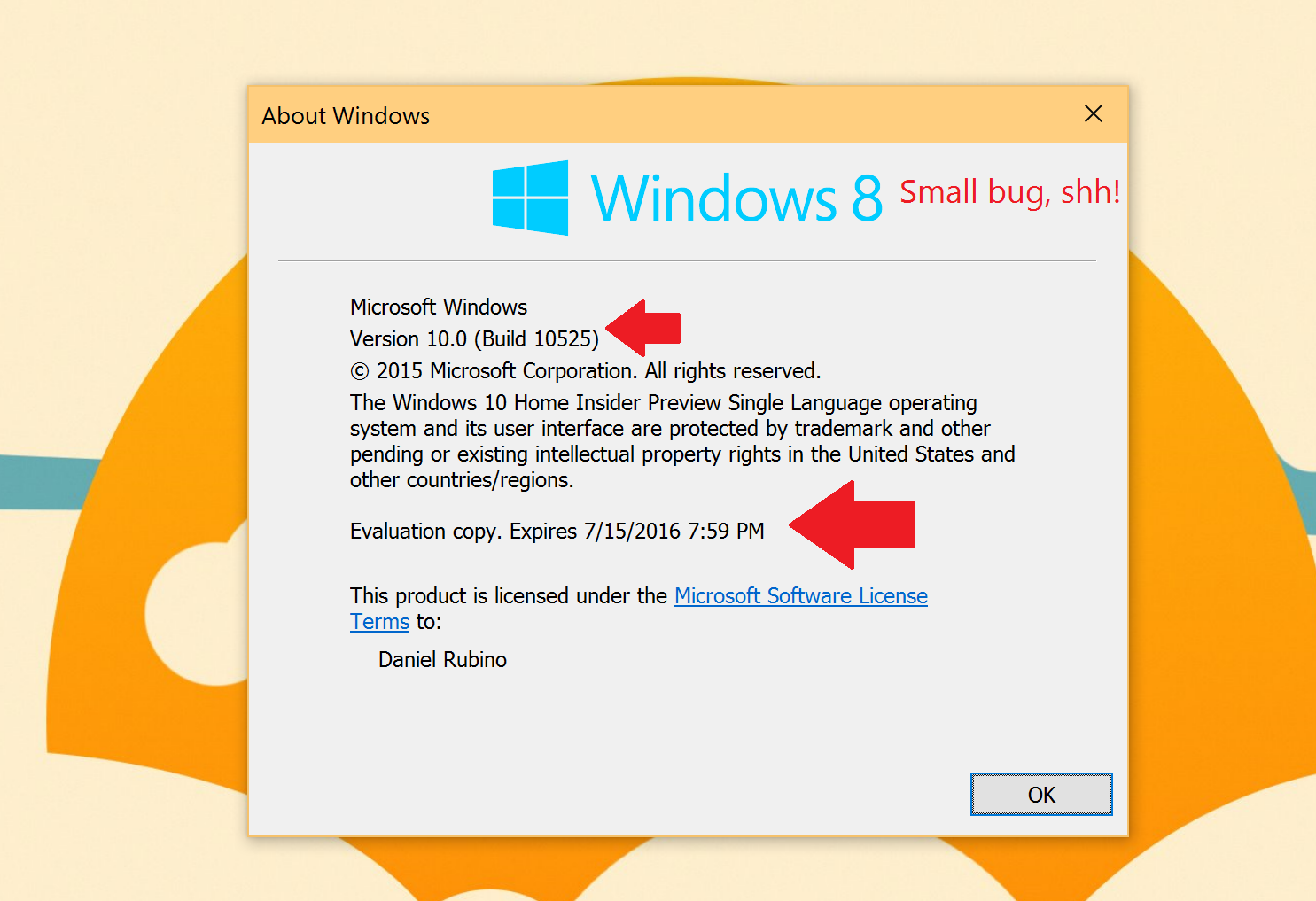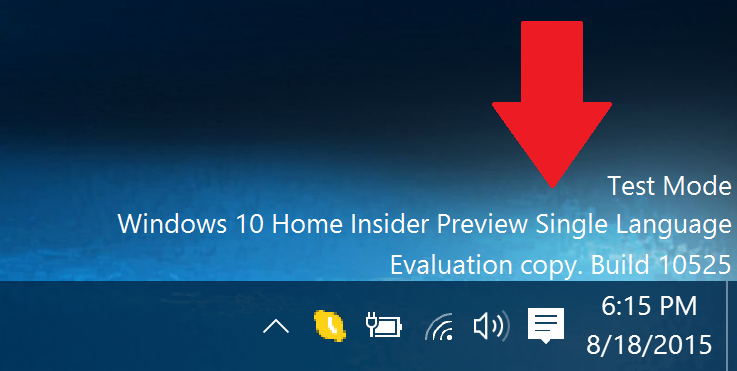Windows 11 Windows 10 Windows 8.1 Windows 7 More…Less
Find operating system info in Windows 11
To find out which version of Windows your device is running, press the Windows logo key + R, type winver in the Open box, and then select OK.
Here’s how to learn more:
-
Under Device specifications > System type, see if you’re running a 32-bit or 64-bit version of Windows.
-
Under Windows specifications, check which edition and version of Windows your device is running.
Related links
-
If you’re having a problem with activation, see Activate in Windows.
-
If you forgot the password you use to sign in to Windows devices or email, see How to reset your Microsoft password.
-
For info about updating Windows, see Windows Update: FAQ.
-
Learn where to Find your Windows product key.
Find operating system info in Windows 10
To find out which version of Windows your device is running, press the Windows logo key key + R, type winver in the Open box, and then select OK.
Here’s how to learn more:
-
Under Device specifications > System type, see if you’re running a 32-bit or 64-bit version of Windows.
-
Under Windows specifications, check which edition and version of Windows your device is running.
Related links
-
If you’re having a problem with activation, see Activate Windows.
-
If you forgot the password you use to sign in to Windows devices or email, see How to reset your Microsoft password.
-
For info about updating Windows, see Windows Update: FAQ.
-
Learn where to Find your Windows product key.
Support for Windows 8.1 has ended
Support for Windows 8.1 ended on January 10, 2023. We recommend you move to a Windows 11 PC to continue to receive security updates from Microsoft.
Learn more
Find operating system info in Windows 8.1 or Windows RT 8.1
To find out which version of Windows your device is running, press the Windows logo key key + R, type winver in the Open box, and then select OK.
If your device is running Windows 8.1 or Windows RT 8.1, here’s how to learn more:
-
If you’re using a touch device, swipe in from the right edge of the screen, tap Settings, and then tap Change PC settings. Continue to step 3.
-
If you’re using a mouse, point to the lower-right corner of the screen, move the mouse pointer up, click Settings, and then click Change PC settings.
-
Select PC and devices > PC info.
-
Under Windows you’ll see which edition and version of Windows your device is running.
-
Under PC > System type you’ll see if you’re running a 32-bit or 64-bit version of Windows.
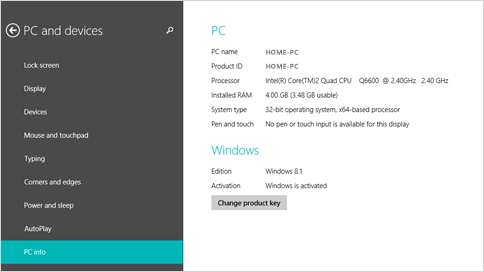
Related links
-
If you’re having a problem with activation, see Activate Windows 7 or Windows 8.1
-
If you forgot the password you use to sign in to Windows devices or email, see How to reset your Microsoft password.
-
For info about updating Windows, see Windows Update: FAQ.
-
Learn where to Find your Windows product key.
Find operating system info in Windows 7
-
Select the Start
button, type Computer in the search box, right-click on Computer, and then select Properties.
-
Under Windows edition, you’ll see the version and edition of Windows that your device is running.
Support for Windows 7 ended on January 14, 2020
We recommend you move to a Windows 11 PC to continue to receive security updates from Microsoft.
Learn more
Related links
-
If you’re having a problem with activation, see Activate Windows 7 or Windows 8.1.
-
If you forgot the password you use to sign in to Windows devices or email, see How to reset your Microsoft password.
-
For info about updating Windows, see Windows Update: FAQ.
-
Learn where to Find your Windows product key.
Need more help?
Want more options?
Explore subscription benefits, browse training courses, learn how to secure your device, and more.
Communities help you ask and answer questions, give feedback, and hear from experts with rich knowledge.
Find solutions to common problems or get help from a support agent.
Самый простой способ быстро узнать версию и билд операционной системы Windows, установленной на компьютере – нажать сочетание клавиш
Win+R
и выполнить команду
winver
.
На скриншоте видно, что на компьютере установлена Windows 10 версия 22H2 (билд 19045.3324). Как номер релиза, так и номер сборки (билда) Windows позволяет однозначно идентифицироваться версию операционной системы на компьютере.
Также можно открыть окно с информацией о системе с помощью сочетания клавиш
Win+Pause
. Это откроет соответствующий раздел Settings (System -> About) или окно свойств системы (в зависимости от версии Windows).
Начиная с Windows 10 20H2, классическое окно свойств системы в Control Panel скрыто и не доступно для прямого запуска. Чтобы вызвать его, выполните команду
shell:::{bb06c0e4-d293-4f75-8a90-cb05b6477eee}
.
Можно получить информацию о билде и версии Windows, установленной на компьютере, из командной строки.
Выполните команду:
systeminfo
Можно отфильтровать вывод утилиты:
systeminfo | findstr /B /C:"OS Name" /B /C:"OS Version"
Или воспользуйтесь WMI командой:
wmic os get Caption, Version, BuildNumber, OSArchitecture
Аналогом команды systeminfo в PowerShell является командлет Get-ComputerInfo:
Get-ComputerInfo | select OsName, OsVersion, WindowsVersion, OsBuildNumber, OsArchitecture
Главный недостаток командлета Get-ComputerInfo – он выполняется довольно долго. Если вам нужно быстро узнать версию и билд Windows из скрипта PowerShell, лучше воспользоваться одной из следующий конструкций.
Версия Windows в переменной окружения:
[System.Environment]::OSVersion.Version
Из WMI класса:
Get-WmiObject -Class Win32_OperatingSystem | fl -Property Caption, Version, BuildNumber
В современных версиях PowerShell Core 7.x вместо командлета Get-WmiObject нужно использовать Get-CimInstance:
Get-CimInstance Win32_OperatingSystem | fl -Property Caption, Version, BuildNumber, OSArchitecture
Значение параметра OSArchitecture позволяет определить установлена ли на компьютере
x86
или
x64
версия Windows.
Можно получить номер билда и версии непосредственно из реестра Windows.
Reg Query "HKLM\SOFTWARE\Microsoft\Windows NT\CurrentVersion" /v ProductName
Reg Query "HKLM\SOFTWARE\Microsoft\Windows NT\CurrentVersion" /v DisplayVersion
Reg Query "HKLM\SOFTWARE\Microsoft\Windows NT\CurrentVersion" /v CurrentBuild
или
Get-ItemProperty -Path "HKLM:\SOFTWARE\Microsoft\Windows NT\CurrentVersion"| select ProductName, DisplayVersion, CurrentBuild
С помощью параметров реестра
ProductVersion
,
TargetReleaseVersion
и
TargetReleaseVersionInfo
в ветке HKLM\SOFTWARE\Policies\Microsoft\Windows\WindowsUpdate вы можете указать версию Windows, до которой ваш компьютер может автоматически обновиться. Эти параметры позволяют также запретить автоматическое обновление ОС до Windows 11.
Вы можете получить информацию о версии Windows на удаленном компьютере через PowerShell Remoting:
Invoke-Command -ScriptBlock {Get-ItemProperty 'HKLM:SOFTWARE\Microsoft\Windows NT\CurrentVersion' | Select-Object ProductName, ReleaseID, CurrentBuild} -ComputerName wksPC01
Или WMI/CIM:
Get-ciminstance Win32_OperatingSystem -ComputerName wksPC01 | Select PSComputerName, Caption, OSArchitecture, Version, BuildNumber | FL
Если компьютер добавлен в домен Active Directory, вы можете получить информацию о версии/билде Windows на компьютере из атрибутов компьютера в AD (как получить список версий и билдов Windows в домене Active Directory).
A Windows Build Version | build number represents a compilation of the operating system code at a particular point in time. The Windows 10 / 11 build version / Build number can be used to identify each Windows version uniquely.
In SCCM | ConfigMgr, you can use WQL query to create collection based on Windows build version to deploy applications or policies to specific operating system version. In Microsoft Intune, you can use build version to create Azure AD group or assignment filters based on OS build number to narrow down your policy deployment scope.
In this blog post, we will document build versions , including current and final versions for Windows 10 and later OS release. We will also discuss how to check build version on a Windows 10 or later devices.
- Windows 11 Operating System Build Version
- Windows 10 Operating System Build Version
- How to Check Windows Build Version on Windows 10 / 11
- How to Check Windows Build Version Through PowerShell
- How to Check Windows Build version for a Device from SCCM Resource Explorer
- Related Posts:
Windows 11 Operating System Build Version
Windows 11 continue to use 10.0 as Windows version. However, the build number start with 22000. So, the Windows version which are greater than or equal to 10.0.22000 are Windows 11 or later release.
| Windows 11 Version | Build Number | Availability Date | End of servicing: Enterprise, Education, IoT Enterprise, and Enterprise multi-session |
| Windows 11 version 23H2 | To be released in Fall of 2023 | ||
| Windows 11 version 22H2 – Latest Version | 10.0.22621 | 2022-09-20 | 2025-10-14 |
| Windows 11 version 22H1 | 10.0.22000 | 2021-10-04 | 2024-10-08 |
Windows 10 Operating System Build Version
Windows 10 operating system version starts with 10.0. The final build number of Windows 10 version 22H2 is 19045. So, the complete version number is 10.0.19045.
| Windows Version | Build Number | Availability date | End of servicing: Enterprise, Education, IoT Enterprise, and Enterprise multi-session |
| Windows 10 version 22H2 (Final Version) | 10.0.19045 | 2022-10-18 | 2025-10-14 |
| Windows 10 version 21H2 | 10.0.19044 | 2021-11-16 | 2024-06-11 |
| Windows 10 version 21H1 | 10.0.19043 | 2021-05-18 | End of Servicing |
| Windows 10 version 20H2 | 10.0.19042 | 2020-10-20 | 2023-05-09 |
| Windows 10 version 2004 | 10.0.19041 | | End of servicing |
| Windows 10 version 1909 | 10.0.18363 | | End of servicing |
| Windows 10 version 1903 | 10.0.18362 | | End of servicing |
| Windows 10 version 1809 | 10.0.17763 | | End of servicing |
| Windows 10 version 1803 | 10.0.17134 | | End of servicing |
| Windows 10 version 1709 | 10.0.16299 | | End of servicing |
| Windows 10 version 1703 | 10.0.15063 | | End of servicing |
| Windows 10 version 1607 | 10.0.14393 | | End of servicing |
| Windows 10 version 1511 | 10.0.10586 | | End of servicing |
| Windows 10 | 10.0.10240 | | End of servicing |
To check build version on Windows 10 / 11 machine, type Winver in search box and select Winver from the result.
Alternatively, you can also press Windows + R key to open Run dialog box. Enter Winver.exe and press enter.
How to Check Windows Build Version Through PowerShell
To check Windows build version from PowerShell, open the PowerShell, type below command and press enter. To check build version for a remote computer you can simply add -CompueterName <Computer Name> partameter with command.
Get-WmiObject -Class Win32_OperatingSystemHow to Check Windows Build version for a Device from SCCM Resource Explorer
SCCM collection OS version details from client machines as part of hardware inventory. You can see all inventory details for an individual client computer from SCCM resource explorer. Follow the below steps to check OS build version for a single device in SCCM
- In SCCM Console, go to Asset and Compliance > Devices , right click a device name, select Start > Resource Explorer
- Select Operating System in Resource Explorer
You can also use SQL query to pull Windows 10 /11 version / build details from SCCM database directly if you need to the information for all devices in your environment. Check out this post SCCM SQL Query for Windows 10 / 11 Build versions for more details.
Related Posts:
- SCCM Dynamic Collection for Windows 10 / 11 Devices
- SCCM SQL Query for Windows 10 / 11 Version Summary
- Configure Windows 10 / 11 Device as Kiosk | Microsoft Intune
- Windows 10 / 11 Operating System Build Versions
- Windows 11 enrollment failed with error 0x800700b7
- Enroll Windows 11 Device to Intune through Azure AD Join method | Corporate Devices
- Invalid_Client error when joining Windows 10 device to Azure AD tenant
- Join Windows 10 Device to Azure Active Directory
- How to Obtain Hardware Hash for Manually Registring Devices with Windows Autopilot
- Bulk enrollment of Windows 10/ 11 Devices to Intune
- Intune – Windows 10 MDM- Basic troubleshooting
- That account info didn’t work – error when disconnecting Windows 10 / 11 Work or School account
- MDM Enroll: Device Credential, Failed (Unknown Win32 Error code : 0xcaa9001f
Subscribe to Techuisitive Newsletter
Be the first to know about our new blog posts. Get our newsletters directly in your inbox and stay up to date about Modern Desktop Management technologies & news.
Время на прочтение
5 мин
Количество просмотров 17K
Как же определить версию Windows, работающую в корпоративном окружении?
Вопрос кажется простым, правда?
Microsoft позволяет определить номер версии Windows различными способами:
- Существуют значения в реестре, которым отчаянно не хватает документации.
- Есть множество командлетов PowerShell, вызовов Windows API и т. п.
- Также есть варианты для конечного пользователя, например, команда
winver, которая вызывает всплывающее окно с версией Windows. - И много других способов…
Разобраться во всём этом вам поможет наш пост.
Существует множество инструментов, позволяющих определить, какая версия Windows запущена у ваших клиентов, например, SCCM и PDQ. В этом посте мы рассмотрим встроенные способы определения версии Windows.
▍ Реестр
Для определения запущенной в системе версии Windows можно использовать следующие значения реестра:
Примечание: перечисленные в таблице значения официально не задокументированы Microsoft (см. ниже).
Предупреждение
Microsoft не сообщала об изменениях в этих значениях реестра, не документировала их официальную поддержку и не гарантировала, что в будущем не появится критических изменений. Из-за этого описанными выше ключами реестра пользоваться бывает иногда неудобно, учитывая непостоянство изменений этих ключей, вносимых Microsoft в прошлом. Примеры:
- ReleaseID не рекомендуется к использованию, начиная с версии 21H1. ReleaseID для 21H1 остаётся равным 2009.
- Server 2012R2 не имеет ReleaseID и DisplayVersion (они пока не были добавлены в Windows)
- Server 2016 имеет ReleaseID (1607), но не имеет DisplayVersion
- Server 2019 имеет ReleaseID (1809), но не имеет DisplayVersion
▍ PowerShell
Ниже приведено несколько примеров того, как можно использовать PowerShell, чтобы определить версию Windows, которая работает в системе:
# При помощи класса System.Environment
[System.Environment]::OSVersion
# При помощи класса CIM Win32_OperatingSystem
Get-CimInstance Win32_OperatingSystem
# При помощи исполняемого файла systeminfo
systeminfo.exe /fo csv | ConvertFrom-Csv
# При помощи командлета Get-ComputerInfo
# ПРИМЕЧАНИЕ: начиная с 21H1 OsHardwareAbstractionLayer не рекомендуется к использованию
Get-ComputerInfo | Select WindowsProductName, WindowsVersion, OsHardwareAbstractionLayer▍ Windows API Call
Единственный поддерживаемый (задокументированный) систематический способ определения версии Windows — при помощи вызова Windows API класса AnalyticsInfo. Это можно сделать через PowerShell:
<#
Класс AnalyticsInfo - задокументированный способ отслеживания версии ОС. Он возвращает
строковое значение. Формат этой строки не задокументирован, и нельзя полагаться
на определённое значение. Эти значения можно использовать только чтобы отличать
одну версию ОС от другой.
https://docs.microsoft.com/uwp/api
/windows.system.profile.analyticsversioninfo.devicefamilyversion
Этот API недоступен на Server Core
#>
$AnalyticsInfo = [Windows.System.Profile.AnalyticsInfo,Windows.System.Profile,ContentType=WindowsRuntime]
$VersionInfo = $AnalyticsInfo.GetMember( 'get_VersionInfo' )
$AnalyticsVersionInfo = $VersionInfo.Invoke( $Null, $Null )
# На моей тестовой машине этот код возвращает `2814751015109593`
$AnalyticsVersionInfo.DeviceFamilyVersion
<#
Строго говоря, строку *можно* парсить, если вам любопытно, что в ней,
хотя этого делать *нельзя*
https://stackoverflow.com/questions/31783604/windows-10-get-devicefamilyversion
#>
$v = [System.Int64]::Parse( $AnalyticsVersionInfo.DeviceFamilyVersion )
$v1 = ( $v -band 0xFFFF000000000000l ) -shr 48
$v2 = ( $v -band 0x0000FFFF00000000l ) -shr 32
$v3 = ( $v -band 0x00000000FFFF0000l ) -shr 16
$v4 = $v -band 0x000000000000FFFFl
# На моей тестовой машине этот код возвращает `10.0.19043.985`
[System.Version]::Parse( "$v1.$v2.$v3.$v4" )
<#
Не опубликовано *никакого* способа декодирования, позволяющего преобразовать
какое-то из приведённых выше значений в удобную для отображения версию,
например `21H1`
Показанная ниже альтернатива доступна только в последних версиях ОС,
начиная с Azure Stack HCI, версии 20H2
#>
Get-ComputerInfo -Property 'osDisplayVersion'▍ Варианты для конечного пользователя
В документации Microsoft перечислено несколько команд, которые конечные пользователи могут применять для определения запущенной версии Windows. Например, чтобы выяснить версию Windows, можно использовать команду winver или меню Параметров Windows. Эти способы предназначаются больше для конечных пользователей, чем для масштабного определения версии системы. Ниже показаны примеры:
▍ Почему это важно
После определения запущенной в системе версии Windows можно использовать эту информацию выполнения детерминированных действий: обновлений Windows, установки патчей и т. п. Например:
Можно запросить значение реестра DisplayVersion (см. раздел «Реестр» выше), чтобы определить запущенную версию Windows. Затем можно задать перечисленные ниже значения реестра, чтобы сообщить Windows, какая версия должна быть запущена в системе. При помощи трёх ключей реестра вы полностью контролируете то, до какой версии Windows ваши системы будут пытаться обновиться!
Эти значения реестра можно задавать или напрямую, или через групповую политику.
▍ Куда двигаться дальше
Хотя вам необязательно управлять версиями Windows, запущенными на компьютерах компании, ей было бы ценно знать, какие это версии Windows. По крайней мере, потому, что Microsoft регулярно прекращает поддержку разных версий Windows.
Стоит также заметить, что показанные выше примеры — это неполный список способов определения версии Windows, однако он полезен для людей, управляющих окружением Windows. Эти способы оказались полезными для меня при устранении проблем, задании политик и т. п. Надеюсь, вам они тоже пригодятся.
Кроме того, ситуация с управлением версиями Windows постоянно меняется, поэтому я напишу ещё один пост, когда Microsoft перестанет рекомендовать перечисленные здесь способы.
Дополнительные ссылки
- Microsoft nixes update deferral settings, but gives us a TargetReleaseVersionInfo
- Windows 10 Version History
- Windows Server Versions.
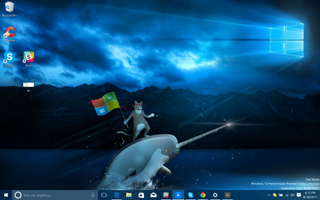
Many users of Windows 10 have a solid idea of which build they are on. In fact, most consumers likely do not know, and that is an OK thing. Windows 10 should be transparent, and users should not have to know the exact build of the OS they are running.
Windows Insiders, however, are a different breed. You, folks, like to keep tabs on every release and sometimes, just sometimes, you may have forgotten which build you are on. Alternatively, sometimes things update but you do not know what changed.
Luckily, you can discover which build you are for Windows 10 in two easy steps. Let’s go!
Check Windows 10 Build Version
1. Win + R
Open up the run command with the Win + R key combo
2. Launch winver
Simply type in winver into the run command text box and hit OK
That is it. You should now see a dialog screen revealing the OS build and registration information.
Another way instead of using Win + R is to (1) type in winver into the Cortana search box and (2) select the first surfaced result.
Note, if you are a Windows 10 Insider, you will likely have an expiration date for the build. No need to fret over this as you can always stop getting insider builds and your OS will revert to a non-expiring edition. In theory, Microsoft is going to keep updating Windows 10 through the Insider Program and this date will continually get pushed back.
How Insiders can stop receiving new builds after Windows 10 launches
Also, as an interesting observation, I noticed my OS shows Windows 8 at the top. Microsoft’s Gabriel Aul notes that this is just a bug and most users will see Windows 10 or even just Windows at the top.
Finally, I am sure many of you have noticed the return of the ‘test mode’ watermark on the 10525 desktop. For Insiders, this is also the easiest way to check your build number 
Anyway, hopefully, you now know how to quickly check your build number!
More Info
For more basic info on Windows 10, including some tips and our vast array of how-to articles, make sure you head to our main Windows 10 help page or jump into our forums!
- Our definitive review of Windows 10
- Windows 10 on Windows Central – All you need to know
- Windows 10 help, tips, and tricks
- Windows 10: Help and discussion forum at Windows Central
All the latest news, reviews, and guides for Windows and Xbox diehards.
Daniel Rubino is the Editor-in-chief of Windows Central, head reviewer, podcast co-host, and analyst. He has been covering Microsoft since 2007 when this site was called WMExperts (and later Windows Phone Central). His interests include Windows, laptops, next-gen computing, and for some reason, watches. Before all this tech stuff, he worked on a Ph.D. in linguistics, watched people sleep (for medical purposes!), and ran the projectors at movie theaters because it was fun.
 button, type Computer in the search box, right-click on Computer, and then select Properties.
button, type Computer in the search box, right-click on Computer, and then select Properties.